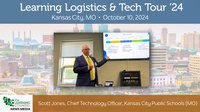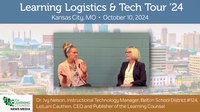As I work with schools and staff, the most often asked question is: How do I engage my students? The frequent follow up to the question is an explanation that their students aren’t interested in school or that their students are not motivated to learn. The use of their students somehow implying that those cherubs are different than other teachers’ students. Given all the tasks teachers are asked to complete it is understandable why some feel this way. That being said, I am here to tell you, all students (and really, all people) want to learn. We, as humans, are innately wired to be curious and want to learn. If you accept this premise, the issue at hand then becomes: My students aren’t motivated and don’t want to learn what I am teaching. Ouch!
My students want to learn but not from me or not what I teach? Most of us will have this epiphany at some point, but it does not help to know we are in good company. I was a secondary school teacher and I hold a deep love of the arts - theatre in particular. I wanted to share that love with my students and I was very surprised when some had unequivocally no interest in what I was offering. It would have been easy for me to decide that my students were not motivated or engaged instead of taking a deep breath and realizing that they were not interested in theatre.
We live in exponential times. What we experienced as students, even just 5 years ago, bears little resemblance to what our kids are now experiencing. Our students are living in one of the most exciting times in human history and their lives are filled with instantaneous feedback, real-world engagements, multi-media presentations, and bleeding edge technology. They live in a world where they can customize almost 100% of their experiences, the exception being their education. To ask students to fully engage in whole-class instruction that may not be meeting their needs in a meaningful way will result in what appears to be apathy. ‘Those kids’ who tune out and otherwise appear unmotivated are still desperate to learn and participate, just maybe not in the way or subject you are teaching.
For as long as we have had schools there have been students who were bored or disinterested. The difference now is that their world comes to them and they customize it to suit their unique interests. They expect no less in the classrooms. As teachers, with enormous responsibilities that extend way beyond the duties of teaching, how do you begin to reach the disinterested in your classroom? Below are three places where you can start:
1. Take the time to know about your students beyond the school day.
TED Talks have become a staple for many of us. We can tune in, select a topic and find hundreds of people sharing their knowledge and stories. What makes a good TED talk? Passion, great storytelling, and the ability to hold an audience’s attention. To take a page from those presenters, TED speakers know how to engage their audience – no matter what the topic. TED speakers connect with the audience in a very personal way and in doing so, ignite curiosity. The modern teacher’s role is no less.
But how do you know what will capture your students’ attention? With 25-40 student in a class, how do reach all of them? It goes back to basics: you have to know them as individuals. It is in the knowing that you build relationships and it is through those relationships that your students will follow where you want them to go. If you cannot make a meaningful connection with your student, it really doesn’t matter how dynamic the topic or how passionate you are about it. Without the connection, students may not be willing to focus and learn. When in doubt, ask your students what they think. Believe me, they will tell you!
2. Get crystal clear about why this concept/idea/lesson is important.
I once worked with two Algebra teachers. They were frustrated because their students were not doing well and they could not understand why. I observed a class and then sat down with the teachers and asked clarifying questions. My first question was ‘why are you teaching this?’ The first teacher responded, ‘because they have to pass the test.’ And the second responded ‘because it is where we are in the pacing guide.’ I took a deep breath, calmed myself, and tried to ask the question again in several other ways including ‘how will they apply this knowledge in the real world?’ and ‘why is it important that they know this?’ They could not answer in any way other than accountability measures – and I knew then why their students had no interest. Would you be interested in sitting through a difficult lesson when it had no relevance to your life? I wouldn’t. To bring this a step closer to home, if you had been asked to sit through a whole-group professional development designed for only a portion of the group, are you interested? Engaged? Probably not.
Sometimes, foundational information must be learned before more inspirational things can be attempted. That is OK. What is not OK is to teach for the purpose of ‘passing a test’ or because it is in the pacing guide! Tests and guides serve as feedback for the teacher – not the REASON the lesson is taught. If you cannot figure out why the lesson might be important for students to learn, you might want to revisit why you are teaching it. Simon Sinek reminds us to Start with the Why and when you clearly articulate the WHY of the lesson, students are much more likely to follow you through the less interesting points to get to the exciting parts.
3. Successful teachers know their subject well and know how to create meaningful ways to share their knowledge.
As a teacher, it is not enough to love your subject. You must have a deep understanding of your topic AND know how to share that understanding with your students. There is no power point in the world that will make your students excited to learn but your passion, energy, ensuring student voice and choice, and understanding of how to best share that information might.
Students are smart and they want you to be a lot smarter than they are – at least about your subject. If you are reading one chapter ahead of your students, they intuit that; if you do not love what you teach, they know. Are you engaged? Checked in? Motivated? If not, chances are your students won’t be either.
Teaching is both an art and a science; great teaching is nothing short of magic. Great teachers open the world to their students in ways that consider their learners’ interests. Great teachers know their content area and through that knowing are able to craft meaningful experiences. Will this kind of teacher reach 100% of students 100% of the time? No. Of course not. But teachers who understand the importance of connections, expertise, and how to share their knowledge will reach most of their students, most of the time and in doing so, maintain their interest.











